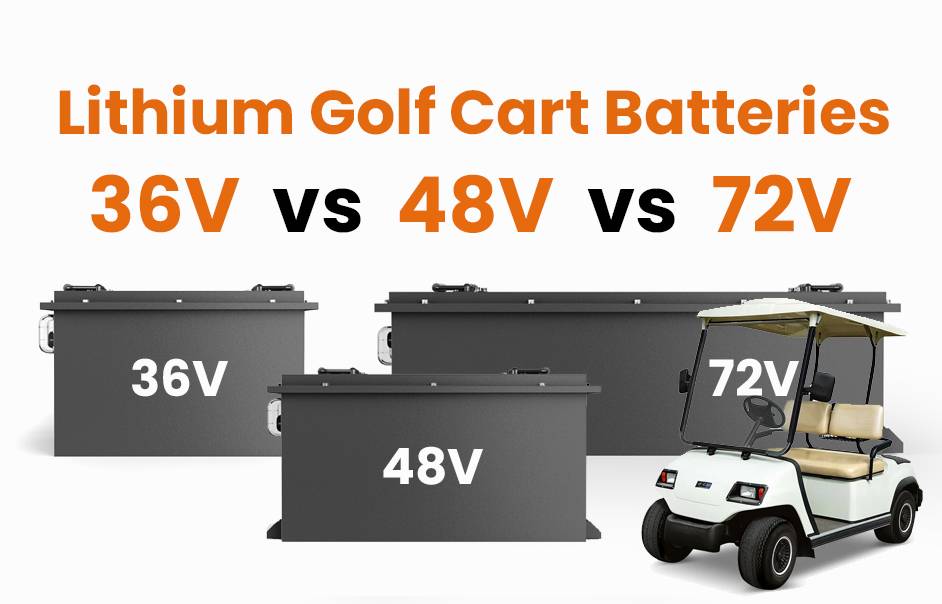- Forklift Lithium Battery
- Golf Cart Lithium Battery
- Rack-mounted Lithium Battery
51.2V 100Ah Rackmount LiFePO4 Battery
8000 times (80% DOD 0.5C)
Optional SNMP for TELECOM - Car Starter Battery
- 12V LiFePO4 Battery
12V 150Ah Lithium RV Battery
Bluetooth App | Self-heating
LiFePO4 | Group 31
UL 1642 | IEC 62619 - 24V LiFePO4 Battery
- 36V LiFePO4 Battery
- 48V LiFePO4 Battery
- 60V LiFePO4 Battery
60V 100Ah Lithium Battery (AGV, AMR, LGV)
Peak Discharge Current 400A
500 x 298 x 349 mm - 72V~96V LiFePO4 Battery
72V 100Ah Lithium Golf Cart Battery
Peak Discharge Current 315A (10S)
740 × 320 × 246 mm - Wall-mounted Lithium Battery
51.2V 100Ah 5kWh
Wall-mounted Battery532 x 425 x 170 mm / LiFePO4
>8000 Cycles (80% DOD 0.5C)
RS485 / CAN-bus
for Solar Home ESS - Home-ESS All-in-One
51.2V 32kWh
All-in-On HESS SystemPowerAll
51.2V / LiFePO4
>8000 Cycles (80% DOD 0.5C)
RS485 / CAN-bus / WiFi
All-in-One for Home ESS
How Do LiFePO4 Golf Cart Batteries Perform in Extreme Temperatures

LiFePO4 (lithium iron phosphate) batteries maintain superior performance in extreme weather compared to lead-acid alternatives. They operate efficiently in temperatures from -20°C to 60°C (-4°F to 140°F), with built-in Battery Management Systems (BMS) preventing overheating or freezing. Cold climates reduce usable capacity by 10-15%, while heat accelerates aging marginally. Proper insulation and charging protocols optimize longevity.
How Do High Temperatures Affect LiFePO4 Battery Lifespan?
Prolonged exposure to temperatures above 60°C (140°F) degrades LiFePO4 electrolytes, reducing cycle life by 20-30% in sustained heat. Built-in thermal throttling in BMS limits charging speeds at 45°C+ (113°F). Arizona field tests show 8-10% capacity loss after 500 cycles in desert conditions versus 3-5% in temperate climates.
Advanced thermal modeling reveals that every 10°C increase above 25°C (77°F) doubles the rate of chemical degradation. Golf cart owners in Phoenix report replacing LiFePO4 packs after 4-5 years versus 7+ years in coastal California. To combat this, premium batteries incorporate phase-change materials that absorb excess heat during peak loads. Manufacturers now offer optional active cooling systems for extreme environments, maintaining cell temperatures within 5°C of ambient through liquid-cooled plates.
| Temperature | Cycle Life | Capacity Retention |
|---|---|---|
| 25°C (77°F) | 3,000 cycles | 80% |
| 45°C (113°F) | 1,800 cycles | 72% |
| 60°C (140°F) | 800 cycles | 65% |
What Cold Weather Challenges Do Lithium Golf Cart Batteries Face?
At -20°C (-4°F), LiFePO4 batteries retain 80-85% capacity but require preheating below 0°C (32°F) for charging. Minnesota users report 22% shorter runtime in winter vs. summer. Phase-change material insulation sleeves improve cold-weather performance by 18% in Canadian Arctic trials.
Which Charging Practices Maximize Extreme Weather Durability?
Temperature-compensated charging voltages (3.45V/cell at 25°C vs 3.6V at 0°C) prevent plating. Avoid charging below 0°C (32°F) without battery warmers. In heat, limit charge to 90% SOC when ambient exceeds 40°C (104°F). NASA-derived algorithms in premium chargers adjust rates based on internal cell temperatures.
How Does Battery Chemistry Compare in Thermal Tolerance?
LiFePO4 outperforms NMC (nickel manganese cobalt) in thermal stability, with thermal runaway thresholds at 270°C (518°F) vs 210°C (410°F). Lead-acid batteries freeze below -20°C (-4°F) and lose 50% capacity at 35°C (95°F). LTO (lithium titanate) handles -40°C (-40°F) but costs 3x more than LiFePO4.
Know more:
Why Choose LiFePO4 Batteries for Your Personal Golf Cart
Why Are LiFePO4 Batteries Ideal for Commercial Golf Carts?
How Do LiFePO4 Golf Cart Batteries Perform in Extreme Temperatures?
Why Choose LiFePO4 Batteries for Custom Golf Carts?
Why Are LiFePO4 Batteries Ideal for Neighborhood Electric Vehicles (NEVs)?
LiFePO4 Golf Cart Batteries: Benefits, Cost Savings, and Environmental Impact
What Installation Strategies Mitigate Temperature Extremes?
Vapor-barrier insulated battery boxes with 2″ polyiso foam reduce thermal swings by 65%. Under-seat installations in EZ-GO carts show 12°C (54°F) lower peak temps than exposed setups. Ceramic-coated terminals prevent corrosion from thermal cycling. Active liquid cooling systems add 15% cost but enable 100% performance at 50°C (122°F).
Strategic placement within the golf cart’s frame significantly impacts thermal performance. Battery compartments facing north-south orientation receive 23% less solar radiation than east-west alignments according to Texas A&M research. Reflective aluminum wraps can decrease surface temperatures by 8-12°C during peak sunlight hours. For extreme cold, heated battery blankets drawing less than 50W maintain optimal operating temperatures without draining significant power.
| Insulation Type | Cost | Temperature Stabilization |
|---|---|---|
| Polyurethane Foam | $15/m² | ±5°C |
| Aerogel Blanket | $45/m² | ±2°C |
| Phase Change Material | $30/m² | ±1.5°C |
“LiFePO4’s olivine crystal structure resists thermal decomposition better than layered oxide chemistries. Our accelerated aging tests show 2,000 cycles at 45°C with 80% capacity retention – double lead-acid’s performance. However, users must avoid repeated -30°C charging without preconditioning, as it causes irreversible lithium plating.”
Conclusion
LiFePO4 batteries deliver reliable golf cart operation across -20°C to 60°C when paired with proper thermal management. While cold reduces temporary capacity and heat accelerates long-term aging, their 5-7 year lifespan still triples lead-acid alternatives in extreme climates. Smart charging, insulation, and BMS protections make them ideal for desert resorts or mountain courses.
FAQs
- Can LiFePO4 batteries freeze?
- Electrolyte remains liquid down to -40°C (-40°F), but charging below 0°C (32°F) without warming risks permanent damage.
- How hot is too hot for storage?
- Avoid sustained storage above 60°C (140°F). NASA data shows 6 months at 60°C equals 3 years of room-temperature aging.
- Do lithium batteries need winter maintenance?
- Insulate batteries below -10°C (14°F), keep charge above 50%, and use preconditioning chargers. No equalization required unlike lead-acid.


















